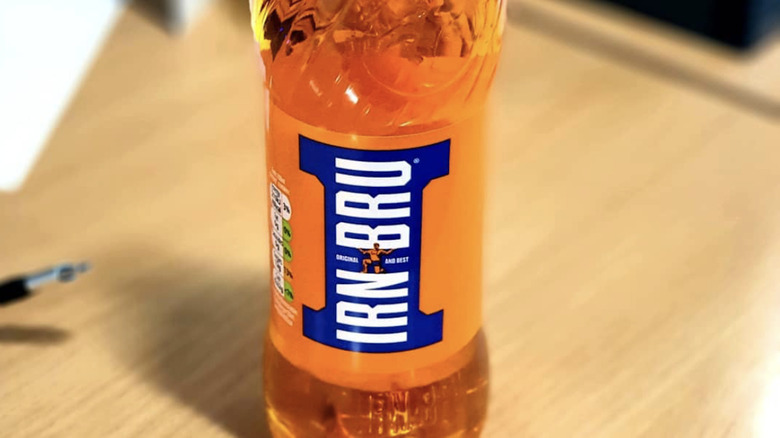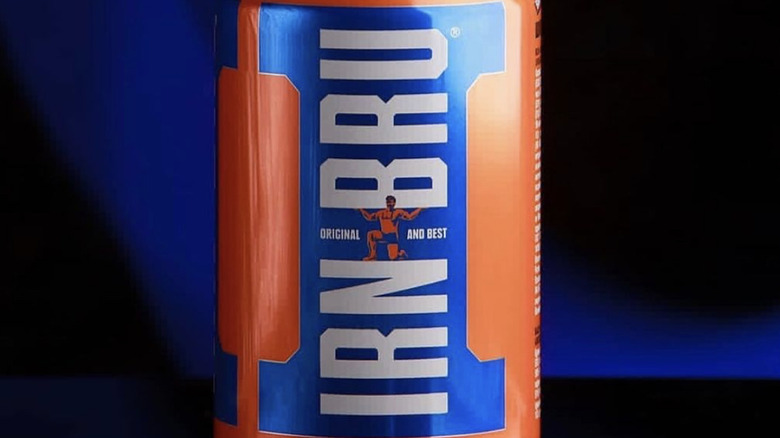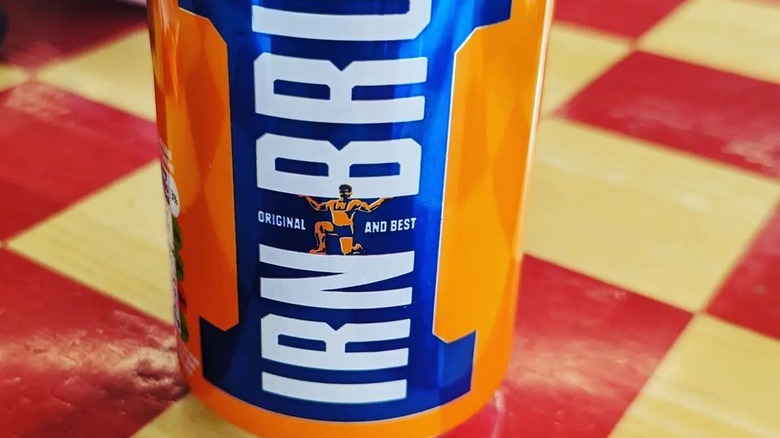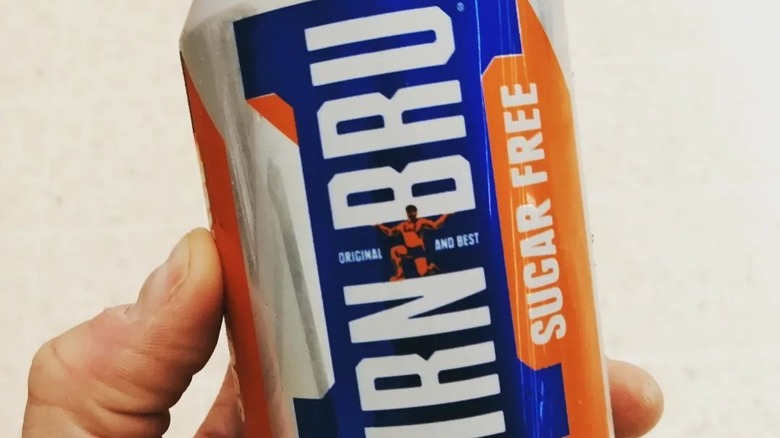Irn-Bru: Scotland's Beloved Soda With A Notoriously Indescribable Flavor
In the early 20th century, most Scottish steelworkers likely eased the burdens of the day's labor with ample swigs of beer. That is until local soft drink manufacturer AG Barr came up with a non-alcoholic replacement: Irn-Bru. The bright orange tonic became associated with tough situations and has since become embedded in Scottish culture thanks to some clever — and at times, controversial — marketing campaigns.
What actually goes into making the colorful beverage remains a carefully protected secret, but some 32 ingredients are mixed into a vat of 8,000 liters at a time. At least 12 cans per second are consumed within the UK, and in Scotland, the soft drink outsells Coca-Cola as per local legend. Widely known as the "other Scottish national drink," Irn-Bru has inspired a variety of product spin-offs and continues to prompt heavy debates on not only the flavor of the drink but also the use of one of Scotland's most well-known cultural markers.
History of the famous drink
In 1947, government regulations dictated that brand names should be as truthful and literal as possible. Since the Irn-Bru drink wasn't actually "brewed" like other, more alcoholic libations, the company took a few vowels out of the name in order to comply with the new mandates.
While the original recipe is still sold (and named 1901, after the year of first production), Irn-Bru Extra, Irn-Bru, Energy, and Energy Sugar-Free are additional varieties of the drink now produced by AG Barr. Each drink contains the same essence that originally brought the drink popularity in the early 1900s. Irn-Bru for Kids and a range of flavored drinks such as Diet Irn Bru, Irn Bru Lightly Sparkling, and Smooth Orange & Cream can be purchased from markets and stores throughout the UK.
Regardless of different packaging and advertising campaigns, the unique taste of this fizzy drink has helped cement its place in Scottish society.
A flavor that sparks discussion
The tangy taste of Irn-Bru is certainly recognizable when placed in a lineup of other kinds of carbonated soft drinks. Yet how to exactly describe the flavor of this orange drink is a bit less clear. Some drinkers insist it tastes like bubblegum, while others identify hints of blackcurrant cordial, orange, and grapefruit.
A Reddit thread has been dedicated to the task of trying to describe Irn-Bru, with users adding salty bananas, cough syrup, marshmallows, and ambrosia from Mount Olympus to the list. More colorful descriptions include magical "rust and battery acid" and a "bubbling highland stream mixed with casual violence. But in a good way."
From barley sugar to an enhanced energy drink, the range of flavor descriptions indicates that Irn-Bru might be one of those products you have to taste to fully understand. And there are plenty of ways to get sampling.
A cultural symbol
You can enjoy Irn-Bru straight out of the can or pour the drink into a glass with crushed ice. The effervescent beverage can be combined with other flavors like ginger ale, root beer, or lemonade to create a soda that suits your own palate and preferences. And of course, the soft drink can be mixed with whiskey. Plus, if you've gone a little too hard the night before, Irn-Bru can help subdue stubborn hangovers. With plenty of sugar and a bit of caffeine, Irn-Bru has been known to brighten even the bleariest of morning-after vision.
Because the flavor of Irn-Bru is massively popular, Irn-Bru has found its way into hard candies, chewy candy bars, shortbread cookies, cupcakes, and even recipes to make cheesy chicken balls. Glasgow Soap Company sells orange lip balm, soaps, candles, and bath salts that pay homage to the drink, so it's possible to literally surround yourself with the beverage.
Can't track down Irn-Bru at your local market? Get online, get ordering, and get tasting. You may very well come up with unique tasting notes of your own.



